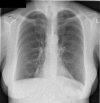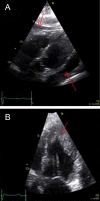Idiopathic eosinophilic myocarditis presenting with features of an acute coronary syndrome
- PMID: 32110421
- PMCID: PMC7040860
- DOI: 10.1530/ERP-19-0044
Idiopathic eosinophilic myocarditis presenting with features of an acute coronary syndrome
Abstract
Summary: A 62-year-old female was admitted with severe left-sided chest pain, nausea and pre-syncope. She had widespread T wave inversion on ECG and elevated troponins and was suspected to have an acute coronary syndrome event. Invasive coronary angiogram revealed normal coronary anatomy with no flow-limiting lesions. Echocardiography and cardiac MRI revealed impaired left ventricular (LV) systolic impairment, a mobile LV apical thrombus and a moderate global pericardial effusion with no significant compromise. Full blood count analysis indicated the patient to have significant eosinophilia, and the patient was diagnosed with idiopathic eosinophilic myocarditis. She was commenced on Prednisolone and Apixaban, and eosinophil levels returned to normal after 10 days of steroids. Over the course of 3 months, the patient had a complete recovery of her LV function and resolution of the LV thrombus. This case highlights a rare, reversible case of idiopathic eosinophilic myocarditis which may present similar to acute coronary syndrome.
Learning points: Eosinophilic myocarditis (EM) is a rare disease that can exhibit symptoms similar to acute coronary syndrome events.The diagnosis of EM should be considered in patients with chest pain, normal coronary angiogram and pronounced eosinophilia levels.Endomyocardial biopsy is the gold standard diagnostic tool; however, it has a low sensitivity detection rate and its use is not indicated in some patients.Echocardiography is useful in the initial detection of cardiac involvement and complications. However, echocardiography lacks diagnostic specificity for all forms of myocarditis including EM.Cardiac magnetic resonance is a useful method and may add in diagnosing all forms of myocarditis including EM.Patients with EM should be identified promptly and treated with high doses of oral glucocorticoid to reduce the risk of permanent cardiac dysfunction.
Keywords: echocardiogram; eosinophilic myocarditis; idiopathic eosinophilic myocarditis; magnetic resonance imaging; thrombus.
© 2019 The authors.
Figures




Similar articles
-
Eosinophilic myocarditis mimicking acute coronary syndrome secondary to idiopathic hypereosinophilic syndrome: a case report.J Med Case Rep. 2010 Feb 6;4:40. doi: 10.1186/1752-1947-4-40. J Med Case Rep. 2010. PMID: 20181108 Free PMC article.
-
Eosinophilic perimyocarditis associated with eosinophilic granulomatosis with polyangiitis: a case report.Eur Heart J Case Rep. 2021 Oct 7;5(10):ytab399. doi: 10.1093/ehjcr/ytab399. eCollection 2021 Oct. Eur Heart J Case Rep. 2021. PMID: 34738066 Free PMC article.
-
Contribution of imaging modalities to eosinophilic myocarditis diagnosis: a case report.Eur Heart J Case Rep. 2022 Feb 7;6(2):ytac058. doi: 10.1093/ehjcr/ytac058. eCollection 2022 Feb. Eur Heart J Case Rep. 2022. PMID: 35295721 Free PMC article.
-
A young female presenting with heart failure secondary to eosinophilic myocarditis: a case report and review of the literature.BMC Res Notes. 2018 Mar 9;11(1):168. doi: 10.1186/s13104-018-3273-1. BMC Res Notes. 2018. PMID: 29523179 Free PMC article. Review.
-
Eosinophilic myocarditis manifesting as myocardial infarction: early diagnosis and successful treatment.Mayo Clin Proc. 1997 Jul;72(7):603-10. Mayo Clin Proc. 1997. PMID: 9212760 Review.
Cited by
-
Eosinophilic Myocarditis: An Often-Overlooked Diagnosis in Patients Presenting with Heart Failure.Case Rep Cardiol. 2022 Jul 1;2022:8453581. doi: 10.1155/2022/8453581. eCollection 2022. Case Rep Cardiol. 2022. PMID: 35813079 Free PMC article.
-
Case Report: Multimodal Imaging Guides the Management of an Eosinophilic Leukemia Patient With Eosinophilic Myocarditis and Intracardiac Thrombus.Front Cardiovasc Med. 2022 Jun 3;9:903323. doi: 10.3389/fcvm.2022.903323. eCollection 2022. Front Cardiovasc Med. 2022. PMID: 35722086 Free PMC article.
-
Direct Oral Anticoagulants for Stroke and Systemic Embolism Prevention in Patients with Left Ventricular Thrombus.J Pers Med. 2023 Jan 14;13(1):158. doi: 10.3390/jpm13010158. J Pers Med. 2023. PMID: 36675819 Free PMC article. Review.
-
The role of rivaroxaban in eosinophilic myocarditis.Eur Heart J Case Rep. 2022 May 26;6(6):ytac219. doi: 10.1093/ehjcr/ytac219. eCollection 2022 Jun. Eur Heart J Case Rep. 2022. PMID: 35712223 Free PMC article.
-
Cardiogenic Shock Induced by Anterior Pituitary Hypofunction and Thyrotoxicosis.Cureus. 2020 Dec 28;12(12):e12347. doi: 10.7759/cureus.12347. Cureus. 2020. PMID: 33520542 Free PMC article.
References
Publication types
LinkOut - more resources
Full Text Sources

